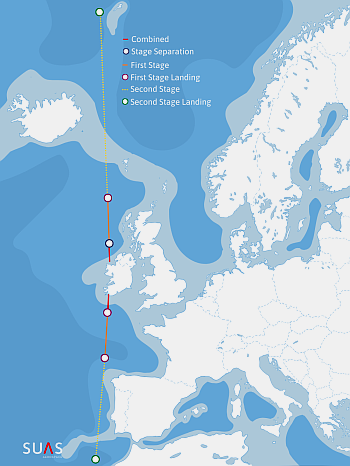Old rockets clash with new rockets in Europe
Two stories today from Andrew Parsonson at his website Europeanspaceflight.com today illustrate the battle going on in Europe’s vast space bureaucracy over its future rocket development, and clearly tell us who is winning.
First Parsonson described a presentation put forth by Arianespace officials at an “Ariane-6 User’s Club” meeting two weeks ago, outlining the planned and proposed upgrades Arianespace intends for the Ariane-6 rocket over the next decade. All the upgrades are focused on increasing the rocket’s payloac capacity. None will make any of the rocket reusable in order to lower its high cost which makes it uncompetitive in the modern launch market.
What was significant about Parsonson’s report is that he also noted that many of these upgrades need to be approved by the European Space Agency (ESA), and its officials won’t make that decision until 2025 during a planned conference. Thus, this presentation by Arianespace was essentially a lobbying effort to convince ESA to approve these upgrades.
Parsonson’s second story then told us what ESA is approving, right now.
The European Space Agency has selected Rocket Factory Augsburg, The Exploration Company, ArianeGroup, and Isar Aerospace to develop reusable rocket technology.
On 9 October, ESA held its Future Space Transportation Award Ceremony in Paris. During the event, the agency announced the four awardees under two initiatives focused on the development of reusable rocket technology: the Technologies for High-thrust Reusable Space Transportation (THRUST!) project and the Boosters for European Space Transportation (BEST!) project.
Except for ArianeGroup, these are new startups. The German companies Rocket Factory and Isar are developing their own rockets, while the French company Exploration has so far focused on making cargo capsules to supply future space stations.
ArianeGroup meanwhile is the joint partnership between Airbus and Safran that built and owns the Ariane-6, and actually has more say on its future than Arianespace, which is merely a government agency that in the past (but no more) managed and controlled all of Europe’s rockets. ArianeGroup hasn’t abandoned Ariane-6 by no means, but clearly is shifting its interests in new directions.
Interestingly, the final decisions on some of these reusable projects will be made at that same 2025 conference.
Want to bet that ESA at that conference shifts its focus from upgrading the non-reusable Ariane-6 and instead goes whole hog for reusability? I expect that, especially because all recent political signs at ESA has indicated no interest in maintaining Arianespace any longer. For example, ESA has taken the Vega family of rockets away from Arianespace and given it back to Avio, the Italian company that manufactures it. ESA has also returned management of French Guiana from Arianespace to France’s space agency, which owns the site.
Designed as the commercial arm of ESA, it no longer has a function, now that Europe is shifting from the Soviet-model of its rocket operation run by the government (Arianespace) to a capitalism model where competing independent companies provide products and services to that government.
Two stories today from Andrew Parsonson at his website Europeanspaceflight.com today illustrate the battle going on in Europe’s vast space bureaucracy over its future rocket development, and clearly tell us who is winning.
First Parsonson described a presentation put forth by Arianespace officials at an “Ariane-6 User’s Club” meeting two weeks ago, outlining the planned and proposed upgrades Arianespace intends for the Ariane-6 rocket over the next decade. All the upgrades are focused on increasing the rocket’s payloac capacity. None will make any of the rocket reusable in order to lower its high cost which makes it uncompetitive in the modern launch market.
What was significant about Parsonson’s report is that he also noted that many of these upgrades need to be approved by the European Space Agency (ESA), and its officials won’t make that decision until 2025 during a planned conference. Thus, this presentation by Arianespace was essentially a lobbying effort to convince ESA to approve these upgrades.
Parsonson’s second story then told us what ESA is approving, right now.
The European Space Agency has selected Rocket Factory Augsburg, The Exploration Company, ArianeGroup, and Isar Aerospace to develop reusable rocket technology.
On 9 October, ESA held its Future Space Transportation Award Ceremony in Paris. During the event, the agency announced the four awardees under two initiatives focused on the development of reusable rocket technology: the Technologies for High-thrust Reusable Space Transportation (THRUST!) project and the Boosters for European Space Transportation (BEST!) project.
Except for ArianeGroup, these are new startups. The German companies Rocket Factory and Isar are developing their own rockets, while the French company Exploration has so far focused on making cargo capsules to supply future space stations.
ArianeGroup meanwhile is the joint partnership between Airbus and Safran that built and owns the Ariane-6, and actually has more say on its future than Arianespace, which is merely a government agency that in the past (but no more) managed and controlled all of Europe’s rockets. ArianeGroup hasn’t abandoned Ariane-6 by no means, but clearly is shifting its interests in new directions.
Interestingly, the final decisions on some of these reusable projects will be made at that same 2025 conference.
Want to bet that ESA at that conference shifts its focus from upgrading the non-reusable Ariane-6 and instead goes whole hog for reusability? I expect that, especially because all recent political signs at ESA has indicated no interest in maintaining Arianespace any longer. For example, ESA has taken the Vega family of rockets away from Arianespace and given it back to Avio, the Italian company that manufactures it. ESA has also returned management of French Guiana from Arianespace to France’s space agency, which owns the site.
Designed as the commercial arm of ESA, it no longer has a function, now that Europe is shifting from the Soviet-model of its rocket operation run by the government (Arianespace) to a capitalism model where competing independent companies provide products and services to that government.


